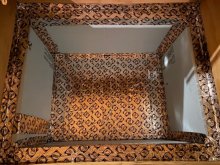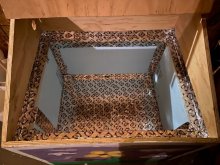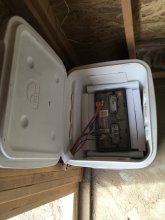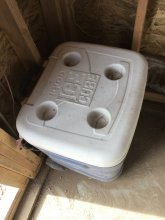My insulated battery box is coming along. I have ordered this seedling heat mat: Heat mat
The dimensions of the heat mat are 10" x 20.75" The dimensions of my cubed 16s pack are 13.5" x 22.5"
The Dupont Styrofoam insulation I used is rated at 15 psi. I have 4" on the bottom (two pieces) and 2" on the sides. I am going to tape the seams with Pella window tape (I have a bunch of it laying around). A 2" piece will rest on top of the side during the cold seasons. So basically my batteries will be inside a heated cooler.
I'm struggling with the installation of the heating pad. I'm thinking of putting a piece of OSB on top of the foam floor and covering it with the foil window tape. Then placing the heating mat on top of the foil taped OSB. Then placing an aluminum plate on top of the mat for heat distribution.
How thick should the aluminum be? Will a square sheet of HVAC duct be OK or is that to thin? I can order a custom cut piece that is 1/4" thick. Should I tape the top of the aluminum with non-conductive tape or are the batteries fine to place on aluminum?
Alternatively I can make an air gap for the heating pad but I'm thinking conductive heat would be better than radiant heat.
Please let me know your guys thoughts. Thanks.

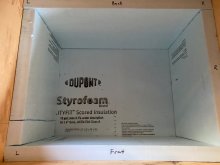


The dimensions of the heat mat are 10" x 20.75" The dimensions of my cubed 16s pack are 13.5" x 22.5"
The Dupont Styrofoam insulation I used is rated at 15 psi. I have 4" on the bottom (two pieces) and 2" on the sides. I am going to tape the seams with Pella window tape (I have a bunch of it laying around). A 2" piece will rest on top of the side during the cold seasons. So basically my batteries will be inside a heated cooler.
I'm struggling with the installation of the heating pad. I'm thinking of putting a piece of OSB on top of the foam floor and covering it with the foil window tape. Then placing the heating mat on top of the foil taped OSB. Then placing an aluminum plate on top of the mat for heat distribution.
How thick should the aluminum be? Will a square sheet of HVAC duct be OK or is that to thin? I can order a custom cut piece that is 1/4" thick. Should I tape the top of the aluminum with non-conductive tape or are the batteries fine to place on aluminum?
Alternatively I can make an air gap for the heating pad but I'm thinking conductive heat would be better than radiant heat.
Please let me know your guys thoughts. Thanks.







